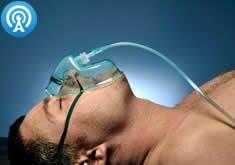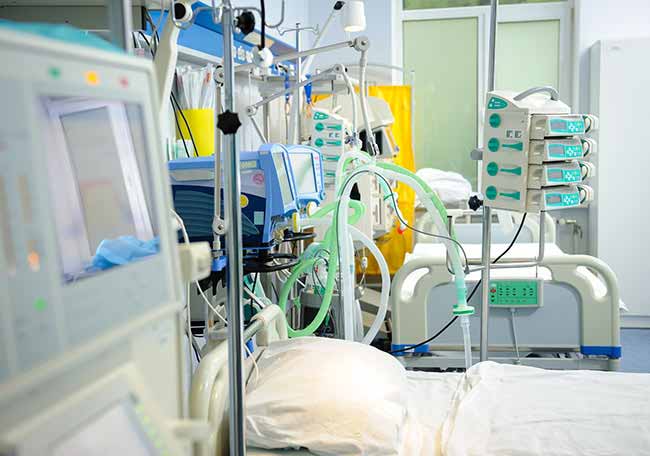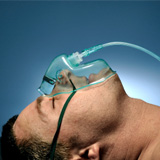Riesgos de la oxigenoterapia en las urgencias médicas

1. Burls A, Emparanza JI, Quinn T, Cabello JB: Oxygen use in acute myocardial infarction: an online survey of health professionals’ practice and beliefs. Emerg Med J 2010, 27:283-286.
2. Steele C: Severe angina pectoris relieved by oxygen inhalations. BMJ 1900,2:1568.
3. Keefer CS, Resnik WH: Angina pectoris: a syndrome caused by anoxemia of the myocardium. Arch Intern Med 1928, 41:769-807.
4. Boland EW: Oxygen in high concentrations for relief of pain in coronary thrombosis and severe angina pectoris. JAMA 1940, 114:1512-1514.
5. Horvat M, Yoshida S, Prakash R, Marcus HS, Swan HJC, Ganz W: Eff ects of oxygen breathing on pacing-induced angina pectoris and other manifestations of coronary insuffi ciency. Circulation 1972, 45:837-844.
6. Madias JE, Madias NE, Hood WB: Precordial ST-segment mapping: 2. Eff ects of oxygen inhalation on ischemic injury in patients with acute myocardial infarction. Circulation 1976, 53:411-417.
7. Russek HI, Regan FD, Naegele CF: One hundred percent oxygen in the treatment of acute myocardial infarction and severe angina pectoris. JAMA 1950, 144: 373-375.
8. MacKenzie GJ, Flenley DC, Taylor SH, McDonald AH, Staunton HP, Donald KW: Circulatory and respiratory studies in myocardial infarction and cardiogenic shock. Lancet 1964, 2:825-832.
9. Thomas M, Malmcroma R, Shillingford J: Haemodynamic eff ects of oxygen in patients with acute myocardial infarction. Brit Heart J 1965, 27:401-407.
10. Kenmure ACF, Murdoch WR, Beattie AD, Marshall JCB, Cameron AJV: Circulatory and metabolic eff ects of oxygen in myocardial infarction. Brit Med J 1968, 4:360-364.
11. Neill WA: Eff ects of arterial hypoxemia and hyperoxia on oxygen availability for myocardial metabolism: patients with and without coronary heart disease. Am J Cardiol 1969, 24:166- 171.
12. Bourassa MG, Campeau L, Bois MA, Rico O: The eff ects of inhalation of 100 per cent oxygen on myocardial lactate metabolism in coronary heart disease. Am J Cardiol 1969, 24:172- 177.
13. Sukumalchantra Y, Levy S, Danzig R, Rubins S, Alpern H, Swan HJ: Correcting arterial hypoxemia by oxygen therapy in patients with acute myocardial infarction. Am J Cardiol 1969, 24:838- 852.
14. Jamieson D, Chance B, Cadenas E, Boveris A: The relation of free radical production to hyperoxia. Annu Rev Physiol 1986, 48:703-719.
15. McNulty PH, Robertson BJ, Tulli MA, Hess J, Harach LA, Scott S, Sinoway LI: Effect of hyperoxia and vitamin C on coronary blood flow in patients with ischaemic heart disease. J Appl Physiol 2007, 102:2040-2045.
16. McNulty PH, King N, Scott S, Hartman G, McCann J, Kozak M, Chambers CE, Demers LM, Sinoway LI: Eff ects of supplemental oxygen administration on coronary blood flow in patients undergoing cardiac catheterization. Am J Physiol Heart Circ Physiol 2005, 288:H1057-H1062.
17. Messina EJ, Sun D, Koller A, Wolin MS, Kaley F: Increases in oxygen tension evoke arteriolar constriction by inhibiting endothelial prostaglandin synthesis. Microvasc Res 1994, 48:151-160.
18. Mouren S, Souktani R, Beaussier M, Abdenour L, Arthaud M, Duvelleroy M, Vicaut E: Mechanisms of coronary vasoconstriction induced by high arterial oxygen tension. Am J Physiol Heart Circ Physiol 1997, 272:H67- H75.
19. Winegrad S, Henrion D, Rappaport L, Samuel JL: Self-protection by cardiac myocytes against hypoxia and hyperoxia. Circ Res 1999, 85:690-698.
20. Haque WA, Boehmer J, Clemson BS, Leuenberger UA, Silber DH, Sinoway LI: Hemodynamic effects of supplemental oxygen administration in congestive heart failure. J Am Coll Cardiol 1996, 27:353-357.
21. Mak S, Egri Z, Tanna G, Colman R, Newton GE: Vitamin C prevents hyperoxia mediated vasoconstriction and impairment of endothelium-dependent vasodilation. Am J Physiol Heart Circ Physiol 2002, 282:H2414-2421.
22. Mak S, Azevedo ER, Liu PP, Newton GE: Effect of hyperoxia on left ventricular function and filling pressures in patients with and without congestive heart failure. Chest 2001, 120:467-473.
23. Park JH, Balmain S, Berry C, Morton JJ, McMurray JJ: Potentially detrimental cardiovascular effects of oxygen in patients with chronic left ventricular systolic dysfunction. Heart 2010, 96:533-538.
24. Welsh DG, Jackson WF, Segal SS: Oxygen induces electromechanical coupling in arteriolar smooth muscle cells: a role for L-type Ca2+ channels. Am J Physiol Heart Circ Physiol 1998, 274:H2018- H2024.
25. Bak Z, Sjöberg F, Rousseau A, Steinvall I, Janerot-Sjoberg B: Human cardiovascular dose-response to supplemental oxygen. Acta Physiol 2007, 191:15-24.
26. Rawles JM, Kenmure AC: Controlled trial of oxygen in uncomplicated myocardial infarction. Br Med J 1976, 1:1121-1123.
27. Ukholkina GB, Kostianov IIu, Kuchkina NV, Grendo EP, Gofman IaB: Effect of oxygen therapy used in combination with reperfusion in patients with acute myocardial infarction. Kardiologiia 2005, 45:59.
28. Cabello JB, Burls A, Emparanza JI, Bayliss S, Quinn T: Oxygen therapy for acute myocardial infarction. Cochrane Database Syst Rev 2010, (6):CD007160.
29. Sassoon CS, Hassell KT, Mahutte CK: Hyperoxic-induced hypercapnia in stable chronic obstructive pulmonary disease. Am Rev Respir Dis 1987,135:907-911.
30. Austin MA, Wills KE, Blizzard L, Walters EH, Wood-Baker R: Effect of high flow oxygen on mortality in chronic obstructive pulmonary disease patients in pre-hospital setting: randomised controlled trial. BMJ 2010, 341:c5462.
31. Watson NA, Beards SC, Altaf N, Kassner A, Jackson A: The effect of hyperoxia on cerebral blood fl ow: a study in healthy volunteers using magnetic resonance phase-contrast angiography. Eur J Anaesthesiol 2000, 17:152-159.
32. Floyd TF, Clark JM, Gelfand R, Detre JA, Ratcliff e S, Guvakov D, Lambertsen CJ, Eckenhoff RG: Independent cerebral vasoconstrictive eff ects of hyperoxia and accompanying arterial hypocapnia at 1 ATA. J Appl Physiol 2003, 95:2453-2461.
33. Rusyniak DE, Kirk MA, May JD, Kao LW, Brizendine EJ, Welch JL, Cordell WH, Alonso RJ: Hyperbaric oxygen therapy in acute ischemic stroke. Results of the Hyperbaric Oxygen in Acute Ischemic Stroke Trial Pilot Study. Stroke 2003, 34:571-574.
34. Bennett MH, Wasiak J, Schnabel A, Kranke P, French C. Hyperbaric oxygen therapy for acute ischaemic stroke. Cochrane Database Syst Rev 2005, (3):CD004954.
35. Padma MV, Bhasin A, Bhatia R, Garg A, Singh MB, Tripathi M, Prasad K: Normobaric oxygen therapy in acute ischemic stroke: a pilot study in Indian patients. Ann Indian Acad Neurol 2010, 13:284-288.
36. Ronning OM, Guldvog B: Should stroke victims routinely receive supplemental oxygen? A quasi-randomized controlled trial. Stroke 1999, 30:2033-2037.
37. ClinicalTrials.gov identifi er NCT00414726: Normobaric oxygen therapy in acute ischemic stroke trial [http://clinicaltrials.gov/show/NCT00414726].
38. Adams HP Jr., del Zoppo G, Alberts MJ, Bhatt DL, Brass L, Furlan A, Grubb RL, Higashida RT, Jauch EC, Kidwell C, Lyden PD, Morgenstern LB, Qureshi AI, Rosenwasser RH, Scott PA, Wijdicks EF; American Heart Association/American Stroke Association Stroke Council; American Heart Association/American Stroke Association Clinical Cardiology Council; American Heart Association/ American Stroke Association Cardiovascular Radiology and Intervention Council; Atherosclerotic Peripheral Vascular Disease Working Group; Quality of Care Outcomes in Research Interdisciplinary Working Group: Guidelines for the early management of adults with ischemic stroke: a guideline from the American Heart Association/American Stroke Association Stroke Council, Clinical Cardiology Council, Cardiovascular Radiology and Intervention Council, and the Atherosclerotic Peripheral Vascular Disease and Quality of Care Outcomes in Research Interdisciplinary Working Groups: The American Academy of Neurology affirms the value of this guideline as an educational tool for neurologists. Circulation 2007, 115:e478-534.
39. Hazinski MF, Nolan JP, Billi JE, Böttiger BW, Bossaert L, de Caen AR, Deakin CD, Drajer S, Eigel B, Hickey RW, Jacobs I, Kleinman ME, Kloeck W, Koster RW, LimSH, Mancini ME, Montgomery WH, Morley PT, Morrison LJ, Nadkarni VM, O’Connor RE, Okada K, Perlman JM, Sayre MR, Shuster M, Soar J, Sunde K, Travers AH, Wyllie J, Zideman D: Part 1: Executive summary: 2010 International Consensus on Cardiopulmonary Resuscitation and Emergency Cardiovascular Care Science With Treatment Recommendations. Circulation 2010, 122:S250-275.
40. Kilgannon JH, Jones AE, Shapiro NI, Angelos MG, Milcarek B, Hunter K, Parillo JE, Trzeciak S. Emergency Medicine Shock Research Network (EMShockNet)
Investigators: Association between arterial hyperoxia following resuscitation from cardiac arrest and in-hospital mortality. JAMA 2010, 303:2165-2171.
41. Kilgannon JH, Jones AE, Parillo JE, Dellinger RP, Milcared B, Hunter K, Shapiro NI, Trzeciak S. Emergency Medicine Shock Research Network (EMShockNet) Investigators: Relationship between supranormal oxygen tension and outcome resuscitation from cardiac arrest. Circulation 2011, 123:2717-2722.
42. Janz DR, Hollenbeck RD, Pollock JS, McPherson JA, Rice TW: Hyperoxia is associated with increased mortality in patients treated with mild therapeutic hypothermia after sudden cardiac arrest. Crit Care Med 2012, 40:3135-3139.
43. Bellomo R, Bailey M, Eastwood GM, Nichol A, Pilcher D, Hart GK, Reade MC, Egi M, Cooper JD: Study of Oxygen in Criticial Care (SOCC) Group. Arterial hyperoxia and in-hospital mortality after resuscitation from cardiac arrest. Crit Care 2011, 15:R90.
44. Kuisma M, Boyd J, Voipio V, Alaspää A, Roine RO, Rosenberg P: Comparison of 30 and the 100% inspired oxygen concentrations during early postresuscitation period: a randomized controlled pilot study. Resuscitation 2006, 69:199-206.
45. Calzia E, Asfar P, Hauser B, Matejovic, Ballestra C, Radermacher P, Georgieff M: Hyperoxia may be benefi cial. Crit Care Med 2010, 38:S559-S568.
46. Rossi P, Tauzin L, Weiss M, Rostain JC, Sainty JM, Boussuges A: Could hyperoxic ventilation impair oxygen delivery in septic patients? Clin Physio Funct Imaging 2007, 27:180-184.
47. Reinhart K, Bloos F, Konig F, Bredle D, Hanneman L: Reversible decrease of oxygen consumption by hyperoxia. Chest 1991, 99:690-694.
48. Dellinger RP, Levy MM, Rhodes A, Annane D, Gerlach H, Opal SM, Sevransky JE, Sprung CL, Douglas IS, Jaeschke R, Osborn TM, Nunally ME, Townsend SE, Reinhart K, Kleinpell RM, Angus DC, Deutschman CS, Machado FR, Rubenfeld GD, Webb S, Beale RJ, Vincent JL, Moreno R: Surviving Sepsis Campaign: International guidelines for management of severe sepsis and septic shock 2012. Intensive Care Med 2013, 39:165-228.
49. Dyson A, Stidwill R, Taylor V, Singer M: The impact of inspired oxygen concentration on tissue oxygenation during progressive haemorrhage. Intensive Care Med 2009, 35:1783-1791.
50. Task Force for Diagnosis and Treatment of Acute and Chronic Heart Failure 2008 of European Society of Cardiology, Dickstein K, Cohen-Solal A, Filippatos G, McMurray JJ, Ponikowski P, Poole-Wilson PA, Strömberg A, van Veldhuisen DJ, Atar D, Hoes AW, Keren A, Mebazaa A, Nieminen M, Priori SG, Swedberg K; ESC Committee for Practice Guidelines, Vahanian A, Camm J, De Caterina R, Dean V, Dickstein K, Filippatos G, Funck-Brentano C, Hellemans I, Kristensen SD, McGregor K, Sechtem U, Silber S, Tendera M, Widimsky P, Zamorano JL: ESC Guidelines for the diagnosis and treatment of acute and chronic heart failure 2008: the Task Force for the Diagnosis and Treatment of Acute and Chronic Heart Failure 2008 of the European Society of Cardiology. Developed in collaboration with the Heart Failure Association of the ESC (HFA) and endorsed by the European Society of Intensive Care Medicine (ESICM). Eur Heart J 2008, 29:2388-2442.
51. Anderson JL, Adams CD, Antman EM, Bridges CR, Califf RM, Casey DE Jr., Chavey WE 2nd, Fesmire FM, Hochman JS, Levin TN, Lincoff AM, Peterson ED, Theroux P, Wenger NK, Wright RS, Smith SC Jr., Jacobs AK, Adams CD, Anderson JL, Antman EM, Halperin JL, Hunt SA, Krumholz HM, Kushner FG, Lytle BW, Nishimura R, Ornato JP, Page RL, Riegel B; American College of Cardiology; American Heart Association Task Force on Practice Guidelines (Writing Committee to Revise the 2002 Guidelines for the Management of Patients With Unstable Angina/Non-ST-Elevation Myocardial Infarction); American College of Emergency Physicians; Society for Cardiovascular Angiography and Interventions; Society of Thoracic Surgeons; American Association of Cardiovascular and Pulmonary Rehabilitation; Society for Academic Emergency Medicine: ACC/AHA 2007 guidelines for the management of patients with unstable angina/non-ST-Elevation myocardial infarction: a report of the American College of Cardiology/ American Heart Association Task Force on Practice Guidelines (Writing Committee to Revise the 2002 Guidelines for the Management of Patients With Unstable Angina/Non-ST-Elevation Myocardial Infarction) developed in collaboration with the American College of Emergency Physicians, the Society for Cardiovascular Angiography and Interventions, and the Society of Thoracic Surgeons endorsed by the American Association of Cardiovascular and Pulmonary Rehabilitation and the Society for Academic Emergency Medicine. J Am Coll Cardiol 2007, 50:e1-e157.
52. O’Driscoll R, Davison A, Elliott M, Howard L, Wedzicha J, Mackway-Jones K, Jenkins P, Kishen R, Levy M, Perrott S, Mansfi eld L, Evans A, Panizzo S, Moore F, Whitmore D, Gibbs S, Martin B, Hinshaw K: BTS guideline for emergency oxygen use in adult patients. Thorax 2008, 63 Suppl 6:vi1-68.
53. Hopkins RO, Weaver LK, Pope D, Orme JF, Bigler ED, Larson-Lohr V: Neuropsychological sequelae and impaired health status in survivors of severe acute respiratory distress syndrome. Am J Respir Crit Care Med 1999, 140:50-56.
54. Gupta AK, Menon DK, Czosnyka M, Smielewsky P, Jones JG: Thresholds for hypoxic cerebral vasodilation in volunteers. Anesth Analg 1997, 85:817-820.
55. Bulte DP, Chiarelli PA, Wise RG, Jezzard P: Cerebral perfusion response to hyperoxia. J Cereb Blood Flow Metab 2007, 27:69-75.
56. Brenner M, Stein D, Hu P, Kufera J, Wooford M, Scalea T: Association between early hyperoxia and worse outcomes after traumatic brain injury. Arch Surg 2012, 147:1042-1046.
57. Lumb AB: Nunn’s Applied Respiratory Physiology. 7th ed. New York: Churchill Livingstone; 2010.
58. Manning HL, Schwartzstein RM: Pathophysiology of dyspnea. N Engl J Med 1995, 333:1547-1553.
59. Cranston JM, Crockett A, Currow D: Oxygen therapy for dyspnoea in adults. Cochrane Database Syst Rev 2008, (3):CD004769.
60. Abernethy AP, McDonald CF, Frith PA, Clark K, Herndon JE 2nd, Marcello J, Young IH, Bull J, Wilcock A, Booth S, Wheeler JL, Tulsky JA, Crocket AJ, Currow DC: Eff ect of palliative oxygen versus room air in relief of breathlessness in patients with refractory dyspnea : a double-blind, randomized controlled trial. Lancet 2010, 376:784-793.
61. Osler W: The Principles and Practice of Medicine. 3rd ed. New York: D. Appleton and Company; 1898.
Comentarios
Para ver los comentarios de sus colegas o para expresar su opinión debe ingresar con su cuenta de IntraMed.











